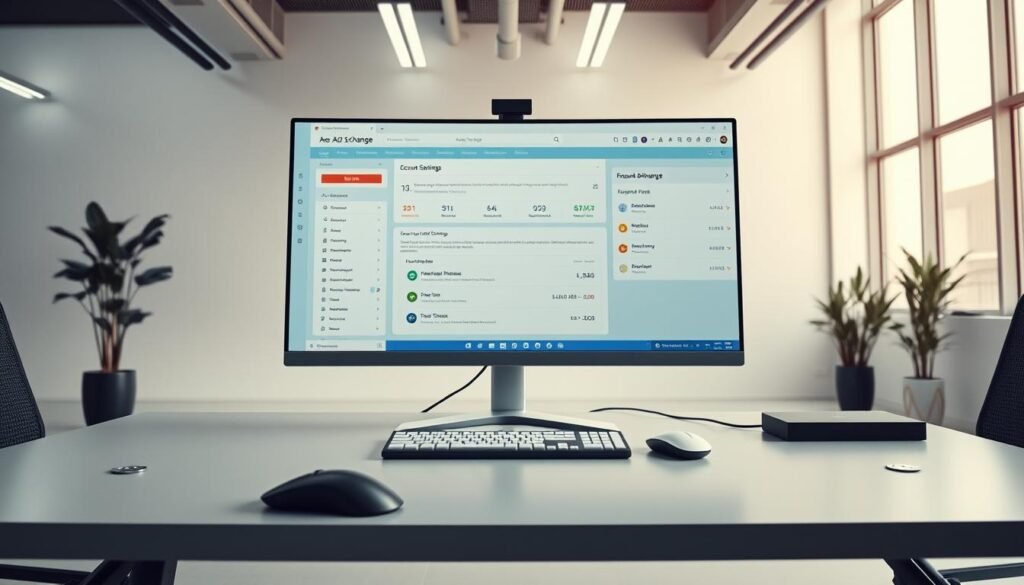The digital ad world has changed a lot with programmatic advertising. The ad exchange platform is at the heart of this change. Real-time bidding (RTB) is key, helping publishers make the most of their ad space.
The Google Ad Exchange is a big name in this field. It makes RTB deals happen between buyers and sellers. This way, publishers get the best price for their ad spots.
This system helps both publishers and advertisers. Advertisers can reach their audience better. So, RTB is a big deal in digital ads.
Key Takeaways
- Real-time bidding enables efficient monetization of ad inventory.
- The ad exchange platform facilitates RTB transactions.
- Programmatic advertising has transformed the digital advertising landscape.
- RTB benefits both publishers and advertisers.
- Targeted advertising is a key advantage of RTB.
What is Google Ad Exchange and Its Role in Digital Advertising
Google Ad Exchange is a key place where publishers and advertisers meet to trade ad space. It’s important for real-time bidding and display advertising. This makes it a vital part of the digital ad world.
Google Ad Exchange is a smart platform that links publishers and advertisers. It helps them buy and sell ad space well. It supports both sides of the digital ad market.

Key Components of Google Ad Exchange
Google Ad Exchange has a few main parts. It allows for real-time bidding, has a big pool of ad space, and uses smart auction systems. These parts help advertisers reach their audience well and publishers make more money.
Difference Between AdSense and Ad Exchange
Many people get confused between Google AdSense and Google Ad Exchange. Both are Google’s platforms for digital ads, but they’re different. AdSense helps publishers make money by showing ads. Ad Exchange is a marketplace for buying and selling ad space, often through bidding.
Evolution of Programmatic Advertising
Programmatic advertising has changed the digital ad world a lot. Google Ad Exchange leads this change, making it easier to buy and sell ad space automatically. This new way of advertising makes things more efficient and based on data.
The Mechanics of Real-Time Bidding
In the world of programmatic advertising, real-time bidding is a key process. It involves advertisers, publishers, demand-side platforms (DSPs), and supply-side platforms (SSPs). This process is complex but essential.
Real-time bidding lets advertisers bid on ad space as it becomes available. DSPs help them manage bids across different platforms. SSPs, on the other hand, help publishers get the most from their ad space by connecting it to various platforms.

The bidding happens fast, almost as quickly as a webpage loads. Here’s how it works:
| Step | Description | Key Players |
|---|---|---|
| 1 | A user visits a webpage with available ad inventory. | Publisher, User |
| 2 | The publisher’s SSP sends a bid request to ad exchanges. | SSP, Ad Exchanges |
| 3 | DSPs connected to the ad exchanges bid on the inventory on behalf of advertisers. | DSPs, Advertisers |
| 4 | The highest bidder wins the ad inventory, and their ad is displayed to the user. | Highest Bidder |
The benefits of real-time bidding are many. For publishers, it means more money from their ad space. For advertisers, it helps them spend their budget wisely by targeting the right audience.
In conclusion, real-time bidding has changed digital advertising. By understanding it and using the right tools, both publishers and advertisers can do better.
Key Players in the Google Ad Exchange Ecosystem
To get the most out of Google Ad Exchange, knowing the key players is key. The ecosystem includes several important groups. They work together to make real-time bidding and programmatic ads work.
Publishers and Their Role
Publishers are the ones who create content and own the ad space. They are vital in the ecosystem. Publishers can boost their earnings by optimizing their ad space and using tools like header bidding and dynamic allocation.

Advertisers and Demand-Side Platforms
Advertisers are the ones buying ad space in the Google Ad Exchange. They use demand-side platforms (DSPs) to bid on ad space that fits their needs. DSPs help advertisers manage bids across many ad exchanges and platforms from one place.
Ad Networks and Supply-Side Platforms
Ad networks connect publishers with advertisers, selling ad space to the highest bidder. Supply-side platforms (SSPs) help publishers manage their ad space and connect with many ad exchanges and DSPs. SSPs aim to sell ad space for the best price, helping publishers earn more.
The Google Ad Exchange ecosystem thrives on the interaction between these players. By understanding the roles of publishers, advertisers, ad networks, and supply-side platforms, everyone can do better in programmatic advertising. This way, they can make more money.
Setting Up Your Google Ad Exchange Account
For publishers looking to boost their ad revenue, starting a Google Ad Exchange account is key. This platform helps manage ad space and connects with many advertisers. It’s a powerful tool for publishers.
Initial Requirements: Before starting, check if you meet the requirements. Google Ad Exchange has rules, like having lots of quality content and following Google’s policies.
To get started, apply on the Google Ad Exchange website. You’ll need to share details about your site or app, like its content and audience.

Setup Process: After approval, you’ll follow a setup guide. This includes making ad units, setting up placements, and adjusting inventory settings. It’s important to place ads well to get more views and clicks.
Google Ad Exchange also lets you link with Google Ad Manager. This makes managing ads easier and can increase your earnings.
| Step | Description |
|---|---|
| 1. Application | Apply through the Google Ad Exchange website with required information. |
| 2. Approval | Wait for Google to review and approve your application. |
| 3. Setup | Create ad units, set up ad placements, and configure inventory settings. |
| 4. Integration | Integrate with other Google advertising products for streamlined management. |
After setting up, keep an eye on how your ads are doing. Google Ad Exchange offers tools to track your ad’s performance. This helps you make smart choices based on data.
By following these steps and using Google Ad Exchange’s tools, publishers can increase their ad earnings. This improves their overall ad strategy.
Understanding Bid Types and Auction Dynamics
In Google Ad Exchange, knowing about bid types and auction dynamics is key to making more money.
Google Ad Exchange uses real-time bidding (RTB). Advertisers bid on ad space as it becomes available. This affects how publishers make money from their ads.
First-Price vs. Second-Price Auctions
Google Ad Exchange has two main auction types: first-price and second-price. In a first-price auction, the highest bidder wins and pays their bid. In a second-price auction, the winner pays the second-highest bid.
Many exchanges now use first-price auctions for their simplicity. But, second-price auctions are used where bid shading is a worry.

Floor Prices and Reserve Rates
Floor prices and reserve rates are important in Google Ad Exchange auctions. A floor price is the lowest price a publisher will accept for their ad space. Reserve rates are similar but are a minimum for the auction to start.
Finding the right floor price is tricky. It’s about making enough money and keeping bidders interested. Publishers must think about their ad’s value, market trends, and demand.
Dynamic Allocation Process
The dynamic allocation process in Google Ad Exchange helps publishers get the most from their ads. It allocates ad space to the highest bidder in real-time.
This ensures the best-paying ad is shown. It works by constantly checking bids and choosing the highest one.
Maximizing Revenue Through Strategic Inventory Management
Effective inventory management is key to boosting ad revenue in the Google Ad Exchange. By smartly managing ad space, publishers can increase their earnings. This improves their online ad business.
Understanding Ad Inventory is the first step. Ad inventory is the ad space on websites or apps. Publishers sell this space to advertisers through Google Ad Exchange. To boost revenue, they must manage their inventory well.

Segmenting ad inventory is a smart strategy. High-value ad spots, like premium placements, can earn more. By focusing on these spots, publishers can make more money.
Dynamic allocation is also vital. It lets publishers sell their ad space to the highest bidder in real-time. This way, they always get the best price for their inventory.
| Inventory Type | Description | Revenue Potencial |
|---|---|---|
| Premium Inventory | High-value ad placements or ad space on high-traffic pages | High |
| Remnant Inventory | Lower-value ad inventory that is not as highly sought after | Low |
By using these monetization strategies, publishers can increase their ad revenue on Google Ad Exchange. Good inventory management is essential to reach the full earning capacity of ad space.
Advanced Targeting Capabilities in Google Ad Exchange
Google Ad Exchange has advanced targeting options. These help advertisers find their audience with precision. This is key in programmatic advertising for better ad delivery and ROI.

Demographic Targeting Options
Demographic targeting in Google Ad Exchange lets advertisers target by age, gender, and more. It’s great for campaigns aimed at specific groups.
Targeting demographics makes ads more relevant. This boosts engagement and conversion rates.
Contextual Targeting Features
Contextual targeting shows ads on sites or apps that match the product or service. It uses keywords and topics for relevance. This ensures ads reach the right audience.
Contextual targeting also keeps ads safe from inappropriate content. It helps maintain brand integrity.
Geographic and Device-Based Targeting
Geographic targeting lets advertisers target by location, from country to postal code. It’s perfect for local businesses or targeting specific areas.
Device-based targeting targets users by device, like desktop or mobile. It helps optimize ads for better user experience and effectiveness.
Using these advanced targeting features, advertisers can make their digital marketing campaigns on Google Ad Exchange more effective.
Data Analytics and Performance Metrics
To succeed in online ads, publishers need to use data analytics and performance metrics. Google Ad Exchange is a great tool for managing ad campaigns. It offers lots of data to help with monetization strategies.
With Google Ad Exchange, publishers can track important metrics like click-through rates and earnings per thousand impressions (eCPM). By looking at these numbers, they can find ways to get better. They can then change their ad spots, formats, and who they target.

Google Ad Exchange also helps publishers understand their audience better. By looking at demographic data and how people interact with their site, they can make ads that really speak to their audience. This can lead to better ad revenue optimization.
Google Ad Exchange gives detailed reports on ad performance. This includes data on impressions, clicks, and conversions. Publishers can use this info to see how well their ads are doing. They can then make smart choices to improve their monetization strategies.
| Metric | Description | Importance |
|---|---|---|
| eCPM | Earnings per thousand impressions | High |
| CTR | Click-through rate | Medium |
| Conversion Rate | Percentage of users who complete a desired action | High |
By using these insights and metrics, publishers can make their ad strategies better. This can help them make more money and do better in the online ad world.
Implementing Effective Pricing Strategies
Pricing strategies are key to making money from your ad inventory on Google Ad Exchange. Knowing how to price your inventory right can help you earn more and stay ahead in the market.
To price your inventory well, you need to know what you have. This means understanding the difference between premium and remnant inventory.
Premium vs. Remnant Inventory
Premium inventory is in high demand. It includes spots like homepage banners or video prerolls. These spots are more valuable because they get seen a lot and can engage users well.
Remnant inventory, on the other hand, is what’s left over. It’s not as sought after but can make money if priced right.
Key differences between premium and remnant inventory include:
| Characteristics | Premium Inventory | Remnant Inventory |
|---|---|---|
| Demand | High demand due to visibility and engagement | Lower demand, leftover ad spaces |
| Pricing | Commands higher prices | Priced lower to attract buyers |
| Revenue Potentia | Higher revenue potencial | Lower revenue potencial, but stil valuable |
Seasonal Pricing Adjustments
Seasonal pricing is also important. Prices can go up during busy times like holidays. This lets you make more money.
But, you might need to lower prices during slow times. This keeps you competitive and attracts buyers.

By understanding these changes and adjusting your prices, you can make more money all year round.
Ad Quality Control and Brand Safety Measures
Keeping ads quality high is key in Google Ad Exchange. As programmatic advertising grows, so does the need for top-notch ad inventory. Google Ad Exchange has tools to make sure ads are good and safe, keeping the ad world clean.
Ad filtering and content verification tools are big helpers. They make sure ads match the content they’re with, making the user experience better. This also cuts down on brand safety problems. Publishers can pick what ads show up, keeping their site in line with their values and what their audience likes.
https://www.youtube.com/watch?v=03VrH_dJKzk
In digital marketing, keeping brands safe is a big deal. Advertisers want to make sure their ads don’t show up next to bad stuff. Google Ad Exchange has brand safety tools like advanced filters and constant checks. These tools spot and stop ads from showing up where they could hurt a brand’s image.
The ad exchange platform also gives detailed reports and analytics. This lets publishers and advertisers see how ads are doing. They can use this info to improve their ad plans and get better results.
| Feature | Description | Benefit |
|---|---|---|
| Ad Filtering | Controls the types of ads displayed | Enhances user experience and brand safety |
| Content Verification | Verifies the quality of ad content | Ensures ads meet quality and safety standards |
| Real-Time Monitoring | Monitors ad performance in real-time | Quick identification and resolution of brand safety issues |
Google Ad Exchange makes a safer, more reliable space for everyone. This boosts the programmatic advertising world and builds trust. It helps the digital marketing field grow and get more innovative.
Integration with Other Google Advertising Products
Google Ad Exchange works well with other Google ads, making your online ads better. This makes your ad strategy more effective and easier to manage.
Working with Google Ad Manager is key to making more money with Google Ad Exchange. Google Ad Manager is a big ad management tool. It helps publishers manage their ads on many platforms.
Google Ad Manager Synchronization
Linking Google Ad Exchange with Google Ad Manager helps publishers manage ads better. This link makes:
- Managing ads easier across many platforms
- Reports and analytics better
- Getting ads out faster and more smoothly
Key Benefits of Google Ad Manager Synchronization:
| Feature | Benefit |
|---|---|
| Unified Inventory Management | Makes managing ads on many platforms simpler |
| Enhanced Reporting | Gives deep insights into how ads are doing |
| Improved Ad Trafficking | Makes getting ads out faster and cuts down on delays |
DV360 Connection Benefits
DV360 is a platform for advertisers to manage their digital ads on many sources. Linking Google Ad Exchange with DV360 brings many benefits, like:
- Access to top-quality ads
- More ways to target ads
- Better ways to measure and improve ads
Benefits of DV360 Integration:
| Feature | Benefit |
|---|---|
| Access to Premium Inventory | Helps advertisers reach the best audiences |
| Advanced Targeting | Allows for very specific targeting |
| Enhanced Campaign Measurement | Gives deep insights into how ads are doing |
By linking Google Ad Exchange with Google Ad Manager and DV360, advertisers and publishers get a powerful set of tools. These tools help them make the most of their digital ads.
Troubleshooting Common RTB Issues
Fixing real-time bidding problems is key to making more money from Google Ad Exchange. RTB involves many players like publishers, advertisers, and ad exchanges. Problems can come from anywhere, affecting how ads work and how they’re managed.
One big issue is with bid request settings. It’s important to set up bid requests right to get good bids. This means choosing the right ad formats, targeting, and floor prices. If the ad format doesn’t match what advertisers can bid on, you might see low fill rates or ads that don’t fit.
Latency and timeout problems are another big challenge. RTB auctions need to happen fast, or you miss out. It’s important to make sure servers respond quickly and that ad exchanges talk well with DSPs and SSPs. This might mean checking and improving the tech behind RTB.
Key Troubleshooting Steps:– Check bid request settings for accuracy and relevance.
– Look into latency and timeout issues, and improve tech as needed.
– Make sure ads are good quality and match what users expect.
Ad quality is also a big issue. Bad ads can make users unhappy and hurt engagement. It’s important to make sure ads are relevant, the right size, and follow publisher rules. Publishers and advertisers should agree on ad quality standards.
To solve RTB problems, you need to understand the RTB world well. This includes knowing who does what and how the tech works. By tackling common issues and following best practices, you can make your RTB efforts better.
Future Trends in Programmatic Advertising
The future of programmatic advertising looks bright, with new ways to target and AI solutions leading the way. As tech advances, it’s key for advertisers and publishers to keep up. This ensures they get the most out of their digital ads.
Cookie-Less Targeting Evolution
The move to cookie-less targeting is a big deal in programmatic ads. With third-party cookies being phased out, new methods are needed to reach audiences.
Key strategies include: using first-party data, contextual targeting, and new tech for precise audience segmentation. These methods don’t rely on cookies.
| Targeting Method | Description | Benefits |
|---|---|---|
| First-Party Data | Using data collected directly from users | High accuracy, enhanced user trust |
| Contextual Targeting | Targeting based on content context | Relevant ad placement, brand safety |
| New Technologies | Innovative solutions for audience segmentation | Precise targeting, improved ROI |
AI and Machine Learning Applications
AI and machine learning are changing programmatic ads for the better. They make ad campaigns more efficient and effective. These techs help optimize ad delivery and improve targeting.
Key applications include: predictive analytics, automated bidding, and personalized ad content.
| AI Application | Description | Benefits |
|---|---|---|
| Predictive Analytics | Forecasting ad performance | Informed decision-making, improved ROI |
| Automated Bidding | Real-time bid optimization | Efficient budget allocation, enhanced campaign performance |
| Personalized Ad Content | Tailoring ad content to individual preferences | Increased user engagement, higher conversion rates |
As programmatic ads evolve, keeping up with these trends is vital. It’s essential for advertisers and publishers to succeed in digital ads.
Conclusion: Maximizing Your Success in Google Ad Exchange
To succeed in Google Ad Exchange, you need to understand how it works. Use programmatic advertising wisely. This means managing your ads well, targeting the right audience, and setting good prices.
Working with Google Ad Exchange means using other Google tools too. This includes Google Ad Manager and DV360. It makes your ad work smoother and better.
The world of digital ads is always changing. Keeping up with new trends and strategies is key. By using data and improving your methods, you can stay ahead in Google Ad Exchange.
